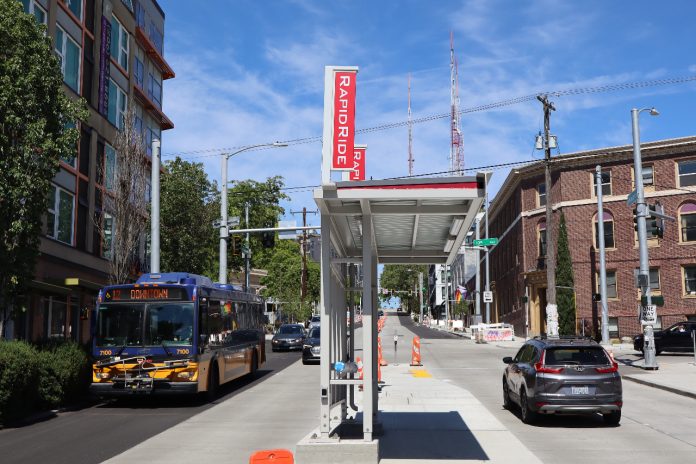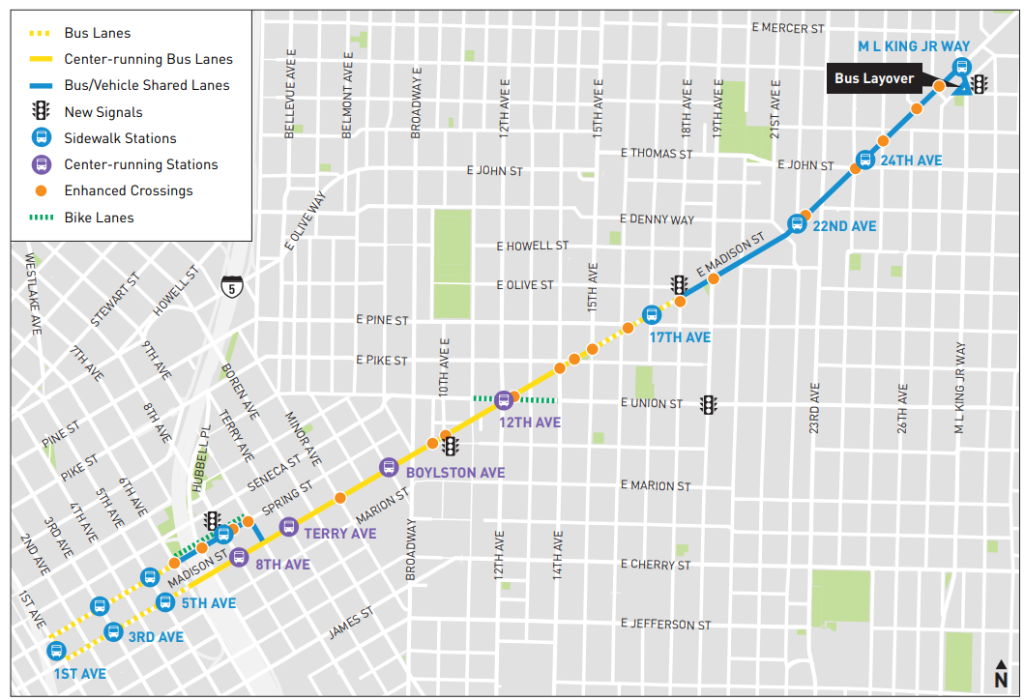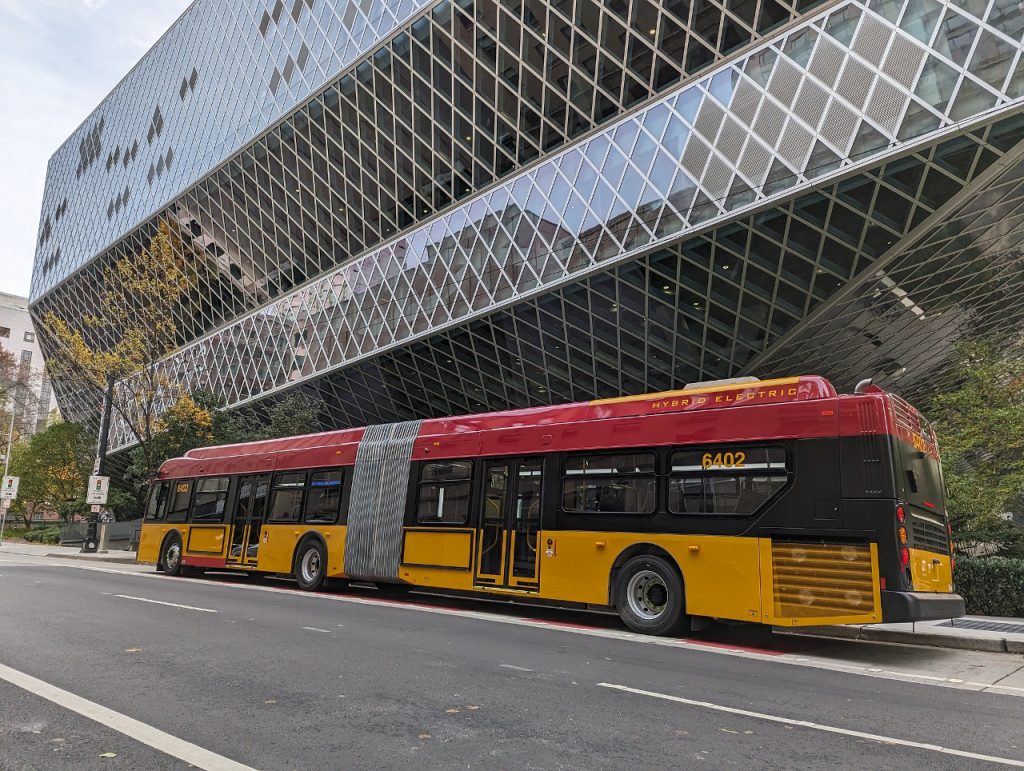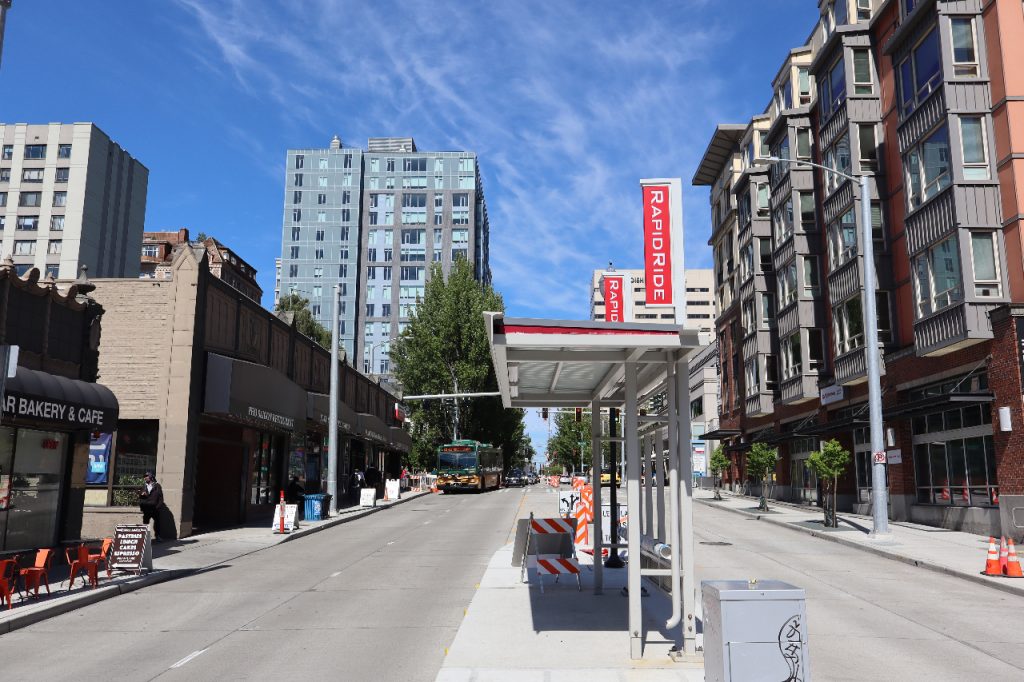
King County Metro promises 6-minute frequency for most of the day, though riders may see some service gaps due to an operator shortage.
In just three months, service is set to begin on the most robust bus rapid transit project that Seattle has ever seen, the RapidRide G Line. With a grand opening planned for Saturday, September 14, King County Metro’s newest RapidRide line will take over for Routes 11 and 12 along Madison Street between Downtown Seattle and Madison Valley, offering both increased frequency and significantly quicker trips for riders along the corridor.
The Seattle Department of Transportation (SDOT), which is managing construction on the $133 million project, confirmed in early June that progress toward completion had surpassed 90% after a long two-and-a-half years of substantial street rebuilding. “All major roadway construction is done, and we’ll continue working on a few sidewalk segments, carrying out some patch work, and making touch-ups along the nearly 2.5-mile-long stretch of roadway,” the June 5 construction update from SDOT noted. Finishing touches will be implemented throughout the summer, including roadway painting and landscaping.
The Urbanist has been covering the long road to get here since 2014, when the first stakeholder sessions kicked off to consider design alternatives for how to serve the Madison Street corridor. Originally set to break ground in 2018, the project was subjected to funding delays during the Trump Administration and construction wasn’t able to fully start until 2021.
For most of the route, including the most congested segments downtown and around I-5, the RapidRide G will operate in its own dedicated bus lanes. Through First Hill and Capitol Hill, buses will run along the center traffic lane, separating them from any other vehicles turning right, and riders will board from brand new stations in the median of Madison Street, mirroring stations along Jackson Street used by the First Hill Streetcar.

With buses stopping both along the curb and at the center medians, King County Metro is adding a fleet of special diesel hybrid electric buses, produced by bus manufacturer New Flyer, with five sets of doors — three on the right and two on the left. The original vision for RapidRide on Madison was a fleet of electric trolleybuses, with trolley wire already in place for much of the route. However, that ultimately proved unobtainable within the project’s budget. The new fleet of New Flyers also include a new feature for Seattle: interior bike racks at the back of the bus, a feature also found on Community Transit Swift buses and TriMet’s FX2 bus rapid transit in Portland.
The RapidRide G fleet will consist of 13 coaches, with nine expected to be in use on most days, leaving four able to be swapped out when maintenance needs arise. Six coaches are currently being outfitted and tested, with the full fleet expected to be in place by the first day of service, according to Metro spokesperson Al Sanders.

After construction on the RapidRide G reaches substantial completion, currently expected in early August, Seattle residents and visitors will start to see vehicles in testing along Madison. In the meantime, Metro has been testing the new coaches at its bus base, using simulations of center-loading bus islands.
The goal for RapidRide G is to offer incredibly frequent service, beating even current train frequency on Link light rail, with buses coming every six minutes between 6am and 7pm Monday through Saturday, dropping to every 15 minutes later at night and on Sundays. That promised schedule dates all the way back to the funding agreement that Metro, the City of Seattle, and the Federal Transit Administration (FTA) signed that led to $59.9 million in federal Small Starts funding flowing to the project.
The question now is whether Metro’s staffing levels, which have been improving in recent months, will be enough to hit those promised frequencies on the RapidRide G. Metro plans to add 143,000 annual service hours onto its bus network, many of which will include trips on the RapidRide G. Hiring and training continues at a slow and steady pace, but the agency may not be at the level needed to hit 6-minute frequencies across the board by September 14. For now, Metro said it is completing over 99% of its scheduled trips, after readjusting service levels to more achievable levels last fall.
With bonuses and increased compensation for operators included in the new contract with the Amalgamated Transit Union (ATU), the bottleneck for getting new bus operators on the road is primarily Metro’s training process. On May 13, Metro posted a recruitment for full-time bus operators and received close to 1,000 applications in one week. But Metro faces limitations on who can train new operators, significantly limiting the size of graduating classes out of operator training.
“We are seeing results from our innovation in this area, but there is still more to do. To have enough trainers on staff to train bus operators at the scale and pace needed to add the number of service hours Metro would like, ATU and Metro will need to come up with new solutions. In short, having more trainers will allow us to add and train more new bus operators, which will allow us to deliver more bus service,” Sanders said.

Metro has relied heavily on overtime to meet its schedule in recent months, with overtime accounting for about double the target of 17% of service.
“Bus operators will be picking their fall assignments in late July and early August, after which RapidRide G Line specific training can increase as we will know which operators will be driving the route. We now have more full-time operators than we’ve had since February 2022. We expect to meet our service hours increase this fall, using overtime to fill shifts as needed,” Sanders continued.
In short, Metro expects a few hiccups this fall, but is expecting staffing to improve in 2025.
“Despite these gains, there may be some cancellations on service system-wide during the first few months of the fall service change, which could temporarily impact some trips on the RapidRide G Line and other bus routes. Reliability will strengthen in early 2025 as we continue to recruit and train new operators.”
Along with the launch of the RapidRide G, bus riders in central Seattle will see substantial changes to the overall network starting September 14. Routing on the 10, 11, and 12 buses will all be reconfigured to better align with the new service on Madison, and Metro will bring back service to the Summit Slope neighborhood of West Capitol Hill via a new extension of the Route 3. Those changes are happening at the same time as another bus restructure around North Seattle and Shoreline as part of the Lynnwood Link extension launch.
With the headaches from the long construction period soon set to be a thing of the past, RapidRide G’s arrival in several of Seattle’s densest neighborhoods will represent a big upgrade to bus service and a major milestone for Seattle’s transit network overall.
Ryan Packer has been writing for The Urbanist since 2015, and currently reports full-time as Contributing Editor. Their beats are transportation, land use, public space, traffic safety, and obscure community meetings. Packer has also reported for other regional outlets including Capitol Hill Seattle, BikePortland, Seattle Met, and PubliCola. They live in the Capitol Hill neighborhood of Seattle.


